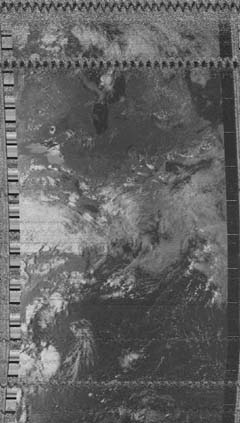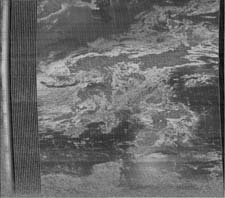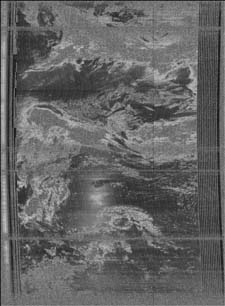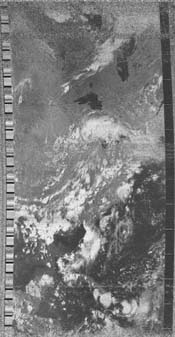
Receiving Weather Satellite Images With Your Macintosh

NOAA-12 Pass (2123z July 29, 2000)
This pass stretches all the way from down in the Caribbean to Hudson Bay, Canada.
It was received on an Icom R-7000 receiver with too narrow of a bandwidth. Also, you can see
some interference from an unknown terrestrial source, I am trying to locate the offender!

Russian RESURS Pass (1620z July 30, 2000)
This pass stretches all the way from the southern part of the Hudson Bay, Canada, down to the tip of the Yucatan.
It was received on an Icom R-7000 receiver with too narrow of a bandwidth, causing distortion of bright (white) areas.

Russian MET 3/5 Pass (1750z July 30, 2000)
It was received on an Icom R-7000 receiver with too narrow of a bandwidth, causing distortion of bright (white) areas.

NOAA-14 Pass (2116z July 29, 2000)
This pass stretches all the way from the tip of the Yucatan to Hudson Bay, Canada.
How to receive weather satellite images
How to receive weather fax over shortwave radio
But, if you want to recieve the images directly from the satellites,
here's what you'll need:
How to receive weather satellite images
The easiest way to receive weather satellite images is to check the
schedules for the HF stations, and find when they're re-transmitting
satellite images.
Other than the above items, receiving the images is similar to receiving
HF weather fax transmissions, except that you have to continuously re-tune
the radio, or have it controlled by your computer!
Also, a given satellite usually only makes one or two passes overhead each
morning and evening. Each pass usually lasts 10 to 15 minutes at the most.
MultiMode
- Decodes weather fax and satellite images on your Macintosh,
without the need for extra hardware.
Return to Black Cat Systems
cps@blackcatsystems.com Chris Smolinski
